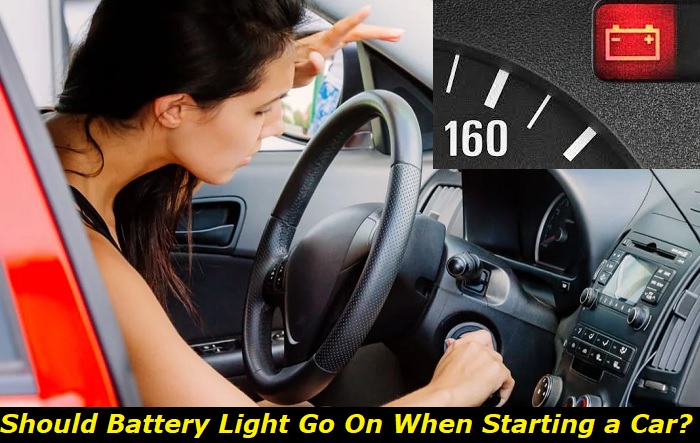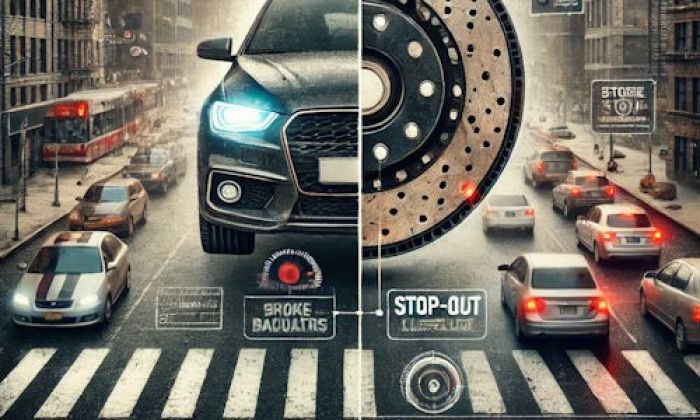A battery light comes on when a vehicle has a charging system issue. However, the battery light coming on and then going off during your car start-up can leave you reeling in confusion. This article will cover whether the battery light coming on when starting your car and then going off is normal. But first, let's look at what it means when the battery light illuminates the dashboard.
Battery light highlights
- Common reasons:battery, alternator, voltage regulator, wires, serpentine belt
- How to fix:check the battery and the alternator, have the car inspected
- Possible consequences:battery may quickly die
- Priority level:High
- Can you drive?Yes
- DIY repair:Possible
- Repair price range:$200-$550

What Does It Mean When the Battery Light Comes on Your Dashboard?
The battery light is also called the dashboard battery indicator. It's a light with a battery symbol that illuminates the dashboard. The symbol has a positive and negative sign. The light usually comes on whenever there's an issue with the battery or other charging system components.
When the battery light comes on, paying attention to it and responding quickly is crucial. You should find out what's wrong through a proper diagnosis and fix it immediately. That's because the light won't go out independently, and failure to fix it can result in more significant issues. There's also the risk of the vehicle running down when driving in the middle of nowhere, leaving you stranded.
How Does the Charging System Work?
The charging system comprises the battery, alternator, electrical cables and wires, and the Electronic Control Unit (ECU) or the voltage regulator. The alternator generates electricity to charge the battery and electronic car accessories. Some electronic accessories include cooling fans, stereo systems, and headlights. Older cars had a dynamo in the place of the alternator.
The alternator has a drive belt or serpentine belt to power it. The belt drives a rotor inside the alternator, which works with an electromagnet to generate an alternating current. The alternator uses a rectifier component to convert the alternating current to direct current in a rectification process. The rectifier has a set of diodes that allow current to pass only in one direction. An ammeter or an indicator shows how much current the alternator generates or the battery's charge state.
The voltage regulator is located in the alternator housing or mounted outside. As the name suggests, the voltage regulator controls the amount of voltage output. This is because the alternator generates high power, which can overload the electrical system or overcharge the battery if not limited. The voltage needs to be between 12.5 -14.5 volts to recharge the battery and supply the electrical system. In modern vehicles, the voltage regulator is part of the ECU.
The car battery is rechargeable and has lead plates dipped in a mixture of Sulphuric acid and distilled water. That setup causes a chemical reaction by allowing ions to move to the terminals to generate charge. The charge is then distributed to the starter motor and other electrical system parts.
Is It Normal for the Battery Light to Come On and Turn Off When Starting the Car?
There's no need to worry when you see the battery light come on and disappear when cranking the engine. That's because it's normal and a common occurrence. Some of the common instances that can cause that are
If the alternator is still producing voltage to power up your starter motor. When the voltage becomes sufficient, the battery light goes off. This usually happens due to a brief surge in power.
If the weather or the environment the car is in is cold. Cold weather can cause the battery charge to dip and cause the battery light to illuminate during starting your car. However, the light disappears when the engine warms up.
During an engine turnover, warning lights appear on the car's dashboard for a few seconds but disappear once the engine starts running. One of these warning lights can be the battery light.
However, what should concern you is if you see the battery light illuminate and then go off when driving, accelerating, or idling. This usually means that a part of the car's charging system is acting up. Another potential cause of concern is if the battery light illuminates while starting the car and stays on for an extended time after the engine runs. That's also an indicator of something amiss in your charging system.
What are the Causes of the Battery Light Staying On After Starting a Car?
The warning battery light can illuminate the dashboard when starting a car and stays on for various reasons. Some of those reasons are
1) A Loose or Damaged Serpentine Belt
The serpentine belt provides the rotational power to make the pulleys in the alternator spin. This generates the power required to charge the battery, which powers the starter motor to start the car. The serpentine belt can slip over the alternator pulley when it becomes loose. This can prevent it from providing enough rotational force making the alternator generate less power.
Random serpentine belt slipping makes the dashboard battery indicator light flash intermittently. The drive belt may also get damaged due to friction from the rotation. What follows is the breakage of the belt that makes the alternator completely unable to generate power.
2) A Battery Issue
A battery can have the issue of being weak or dead. When the battery is weak, it creates a power surge. This means the battery won't have enough charge to power the electrical system. The decline in power makes the warning battery light appear on the dashboard. The battery can become dead after the expiry of its shelf life.
The shelf life of a vehicle's battery is 3-5 years. That's why manufacturers recommend replacing the battery once it serves the car for five years. Once the battery surpasses its shelf life, it can fail anytime, making the light come on.
3) Presence of Corrosion on the Battery Terminals
Another issue that can cause the battery warning light to appear on the instrument panel is corrosion on the battery terminals. Corrosion comes onto the battery as it continues to age. A bit of corrosion on the terminals doesn't affect the battery performance, but it has adverse effects when the corrosion becomes excessive.
The corrosion reduces the contact between the battery terminals and its cables. This reduces the electrical conductivity between them. Once the conductivity is reduced, the charge entering the battery from the alternator decreases. The battery also won't be able to produce sufficient voltage to power the electronic components in the car. The battery light may also come on and off intermittently.
4) A Faulty Alternator
The alternator converts the mechanical energy from the rotation of the rotor to electrical energy. Various alternator components can fail, leading to a decline or lack of voltage output. Some of those components are diodes, decoupler pulleys, and bearings. If these components are damaged or not operating optimally, the battery light will flash on the instrument panel.
A frayed or loose wiring connection in the alternator may also affect its performance. To diagnose if the alternator is functioning correctly, one should use a multimeter or voltmeter to check its voltage output.
The voltage output should be between 12.5 and 14.5 while the engine runs. Anything below that indicates that the alternator has an issue. The alternator's voltage output has to be higher than the battery's voltage for the charging system to work correctly.
5) Faulty Voltage Regulator
As we looked at earlier, the voltage regulator limits the voltage from the alternator to the battery and other electronic components. This prevents the overloading of the electrical system. It also allows electronic components like air conditioners, stereo systems, headlights, and internal lights to function correctly.
When the voltage regulator malfunctions, the alternator overcharges the car battery causing it to become hot, resulting in damage. It can also cause the battery to crack, leak, increase its corrosion, and give off an acidic smell causing it to become faulty. What follows is the battery light coming on the dashboard.
How to Diagnose and Trouble-Shoot Your Charging System
The first step to diagnosing your system is to check the condition of your battery. Start by checking its terminals for any sign of corrosion. If the battery has corrosion, you'll see some green or whitish deposits on the terminals. Those need to be cleaned off. A cleaning tool or commercial cleaner can help clean the corrosion. You can also visit a local auto shop to have the terminals cleaned.
If your battery terminals have no corrosion, you can proceed to check the battery cables. The cables should be tight to allow good electrical flow. To determine the battery's health, use a voltmeter or multimeter to check the battery's terminal charging voltage. The voltage should read 12.5V and above. The reading should read 13.7-14.7V with the engine running. A failing battery also has other symptoms, such as:
- Dim headlights, internal cabin lights, and tail lights.
- Engine backfires.
- The vehicle takes time to start.
- Some electronics intermittently come on and off.
Another charging component to diagnose is the alternator. Failure of the alternator can lead to overcharging or undercharging of the charging system. One way to determine if the alternator is in good condition is to remove the negative terminal while the engine is running.
The engine should continue running if it's in good condition. If it's faulty, the engine may run out or stall. After checking the alternator, check if the voltage regulator is functioning correctly. A faulty voltage regulator will allow high voltage to enter the electrical system and overcharge the battery.
Bottom Line
There you go-whether it's normal for the battery light to come on and then go off during start-up. It's pretty standard for the battery to illuminate the dashboard and then go off during start-up. However, you should be concerned if it comes on during idling, driving, or accelerating. To be safe, consult your mechanic if you can't diagnose the charging system yourself when the battery light comes on.
About the authors
The CarAraC research team is composed of seasoned auto mechanics and automotive industry professionals, including individuals with advanced degrees and certifications in their field. Our team members boast prestigious credentials, reflecting their extensive knowledge and skills. These qualifications include: IMI: Institute of the Motor Industry, ASE-Certified Master Automobile Technicians; Coventry University, Graduate of MA in Automotive Journalism; Politecnico di Torino, Italy, MS Automotive Engineering; Ss. Cyril and Methodius University in Skopje, Mechanical University in Skopje; TOC Automotive College; DHA Suffa University, Department of Mechanical Engineering






Add comment